
The term cliffhanger is thought to derive from the film serials in the early days of cinema, where the square-jawed hero (or hapless heroine) would typically be hanging off the edge of a cliff, enticing audiences to tune in next week to see how they'd escape from this perilous predicament. The horror genre is no stranger to the cliffhanger, with every film hoping to be a franchise ending with a sly nod or a wink to the audience that the bad guy still lives, or the aliens aren't quite as defeated as you'd been led to believe. Few slashers end with the permanent death of the antagonist, for instance, because they'll invariably be back for the sequel, providing the movie did well enough at the box office.
At its best, a good cliffhanger promises an exciting resolution in the next movie or looks like it's taking the franchise in a direction you wouldn't have predicted. Sometimes they can form the basis of an open ending, leaving the audience to contemplate what happens next. In the case of a few films on the list, the cliffhanger was never resolved, leaving the audience hanging in perpetuity. So, as to not leave you in the suspense, here are 15 of the best. (Spoilers ahead).
Dawn Of The Dead (1978)

George A. Romero's original "Dawn of the Dead" and the Zack Snyder remake both have cliffhanger endings, with the characters from each film having fled the mall which has been their fortress and home. However, the end credits of the latter seem to indicate that the freedom of their new island home is short-lived, with their yacht being overwhelmed by a swarm of ferocious zombies. There's certainly not much ambiguity there!
The former is more open-ended, with Peter and Fran — the only two humans left alive in the mall — escaping in a helicopter, flying off to an uncertain fate. Romero's 1985 sequel "Day of the Dead" certainly indicates the zombie outbreak is set to grow far, far worse, but perhaps there's still some story to tell about these two survivors. It's clear from the events in the film that they're both more than capable of looking after themselves; like the survivors of "Day of the Dead," perhaps their chances of survival are higher than average.
The Autopsy Of Jane Doe (2016)
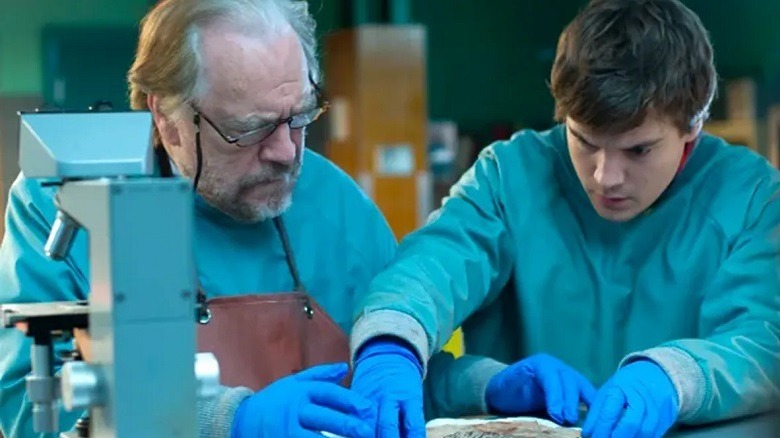
Morgues are, for obvious reasons, horrifying enough places at the best of times. When you're performing an autopsy on a body that you soon suspect may be a witch (whose powers are not quite as dead as the body on the slab), they become a site of sheer terror. Despite stellar performances from both Emile Hirsch and Brian Cox, the 2016 horror "The Autopsy of Jane Doe" flew under the radar of many — but it's as an effective chiller now as it was then.
The fact that the antagonist is still alive at the conclusion of the movie is nothing new in horror, but the intriguing central premise and unfolding mystery behind the titular corpse makes this one movie where it's genuinely sad that it was never followed up on. Horror franchises have gone on to thrive with far weaker premises, and this little gem is a perfect example of atmospheric horror done right. You'll never be able to listen to "Open Up Your Heart (And Let The Sunshine In)" the same way ever again.
Freddy Vs. Jason (2003)
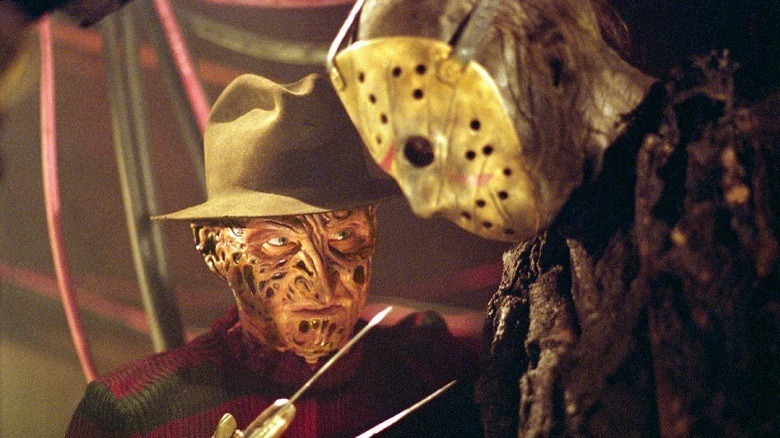
This entry sits on the list for sheer chutzpah alone. The movie, pitting two of cinema's greatest supernatural slashers against each other, had been in development hell for an age. The titanic struggle had been hinted at in the conclusion of "Jason Goes to Hell: The Final Friday," which saw Jason's discarded and cracked hockey mask dragged under the earth by Freddy Krueger's signature clawed glove. The actual face-off wouldn't be realized in cinema for a decade.
Was it worth the wait? Your mileage may vary, but there was no denying the sheer cinematic spectacle of seeing that famous glove pitted against the equally infamous machete. Contrary to the title, the twisted twosome doesn't really get into a proper scrap until the last act of the film. Then, the conclusion of that epic battle sees them both vanish under the waters of Crystal Lake, with only one victor emerging — but what an ending. Jason emerges, triumphantly holding the severed head of Freddy, which then proceeds to wink at the audience in a way that clearly indicates the fight isn't over yet. Sadly, though, a sequel to "Freddy vs. Jason" never materialized.
The Thing (1982)

"Why don't we just wait for a little while, see what happens?" And with that final line from Kurt Russell's R.J. MacReady, the synthesized heartbeat of John Carpenter's soundtrack for "The Thing" kicks in, and we're left none the wiser as to the ultimate fate of the two survivors of Outpost 31. The titular amorphous extra-terrestrial has possibly been defeated in the destruction of said base, but neither of the two survivors — MacReady and Keith David's Childs — know if the other is infected.
Fans have had countless speculations about the ending of "The Thing," with theories abounding about the glints in characters' eyes revealing their true nature, or even their visible breaths. "The Thing" would ultimately get a sequel of sorts in a Dark Horse comic series in 1991, which saw the continuation of the film's storyline. It could be argued, however, whether this is part of the true canon or not. A proposed alternate ending would have removed nearly all the ambiguity, but thankfully audiences were left with a perfect open-ended conclusion that hammers home the central theme of the movie: paranoia and the terror of the unknown.
The Birds (1963)
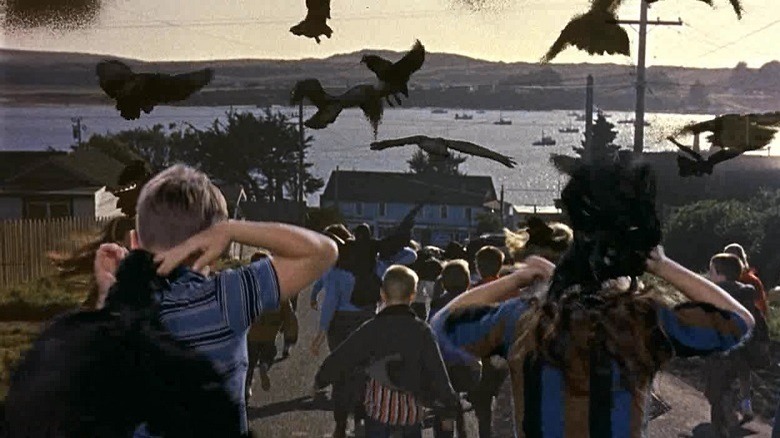
Socialite Melanie travels to the small sleepy coastal town of Bodega Bay, California, but is unprepared when all the birds in the area begin to randomly attack the populace. Perhaps finally bored of being caged, roasted, and having their unborn children poached, scrambled, or fried, these avian ex-allies have finally had un œuf of mankind. Either way, in the same manner in which it is never discovered why the once feathered friends have suddenly turned on humans, the 1963 Alfred Hitchcock movie ends without resolution.
As you'd expect from the master of suspense, it's an effective open ending. You never truly learn of the extent to which the phenomenon is occurring elsewhere or just confined to Bodega Bay, or whether the leads can ever escape the nightmare at all. A poor made-for-TV sequel did eventually appear 31 years after the original, titled "The Birds 2: Land's End," but even the director tried to remove himself from the credits. All in all, it's pretty low down in the pecking order of sequels you need to watch, and definitely not worthy of a double-bill.
Evil Dead 2: Dead By Dawn (1987)

The original ending of the third installment in the "Evil Dead" franchise, "Army of Darkness," almost made it onto this list, where Ash accidentally swallows too many droplets of sleeping potion and ends up in a post-apocalyptic future. But it's the ending of the second film, "Evil Dead 2: Dead by Dawn," that truly stands out.
Effectively a bigger budget version of the original with more black humor, the climax of the sequel sees an incantation from the Necronomicon open a vortex which pulls in the troublesome demon that's been plaguing the cabin dwelling characters. Unfortunately, it also pulls in hapless hero Ash and his 1973 Oldsmobile, dumping them both unceremoniously back in the middle ages.
Oblivious to the fact that ammo won't be available for more than five hundred years, Ash saves some knights from a winged Deadite with a blast of his shotgun. Hailed as a hero, an anguished Ash realizes he's trapped in the past. As an ending meant to change the dynamic of the series, it's nothing short of remarkable. It would later be met with a satisfying pay-off in the 1992 sequel, which missed a trick in not having the official subtitle "The Medieval Dead."
Brightburn (2019)

Comics have often toyed with the idea of contemplating what would happen if there were an evil variant of Superman, or if something turned the Man of Steel himself that way. The 2019 superhero horror flick "Brightburn," however, presented audiences with a promising premise: "What if Superman was just born evil?"
At the end of the movie, the super-powered child, Brandon Breyer (can't be a Superman analog without an alliterative name), has killed both of his parents and downed a commercial airliner to cover his tracks. As the strains of Billie Eilish's "Bad Guy" plays over the end credits, Brandon's continued murderous spree, toying with mankind as though they were insects. The foundations of a sequel with the world fighting against a super-powered child are fascinating enough, but the film introduces an Alex Jones-esque shock jock (played by Michael Rooker) hinting that Brightburn — dubbed as such by humanity at this stage — is merely one of several superhumans who exist. Intriguingly, one of the others is shown as Rainn Wilson's Crimson Bolt from the violent superhero movie "Super," which would be an intriguing crossover indeed.
The Void (2016)

2016's "The Void" is a Canadian H.P. Lovecraft-inspired trip into darkness, following a group of disparate characters trapped inside a hospital — which may or may not be a gateway to hell — by bizarre cultists. An indie horror film notable for its gore and some outstanding practical effects, it's essentially a nihilistic siege movie with a great deal of ambiguity.
At the end of the movie, two of the leads, Sheriff Daniel Carter (Aaron Poole), and his estranged nurse wife, Allison (Kathleen Munroe), find themselves having passed into the titular void, standing on an alien landscape beneath an otherworldly black pyramid. It's an ending reminiscent of the conclusion of Lucio Fulci's 1983 Spanish horror "The Beyond," which also sees its two leads stranded in a nightmarish world. Sadly, both movies abruptly end there. The explorations of the couples would not go beyond these films, leaving the secrets of both eternally untold.
10 Cloverfield Lane (2016)

Opinions are wildly divided on the concluding act of this movie, which begins as a taut hostage thriller but ends as something quite different, as though Rod Serling from "The Twilight Zone" was let loose on the last chapter of an Alfred Hitchcock screenplay. The name alone should have been an indicator enough that it tied into the "Cloverfield" universe, but a few critics complained about the whiplash of a drama about a kidnapped girl suddenly turning into an alien invasion movie.
Having escaped from the clutches of an underground bunker ruled by the tyrannical and obsessive Howard (sinisterly portrayed by John Goodman), Michelle (Mary Elizabeth Winstead) conquers some of the pesky aliens on the surface and decides to join the human resistance. Sadly, this intriguing storyline would never be continued. The execrable "The Cloverfield Paradox" — released two years later — feels completely unrelated, seemingly even more shoe-horned into the franchise than this movie.
The Blair Witch Project (1999)

The strength of this independent found-footage horror is its ambiguity and the sense of mystery that pervades every frame. Threats are briefly glanced at or only heard, and it succeeds through building up an oppressive sense of atmosphere based on a strong and troubling mythology.
The movie follows three film students and their exploits in Maryland to document a fabled witch who once lived in the area, along with her connections to a serial killer from the 1940s. Eventually, lost and missing one of their numbers, they stumble across the serial killer's old abode. It's in this ramshackle hovel that they both learn that the legends are more than myth, and the Blair Witch is just as active today. An effective and chilling conclusion provides just enough hook to warrant a sequel. Unfortunately, the resultant follow-up, "Book of Shadows: Blair Witch 2," was as conventional as the first movie was different, and as mediocre as the first film was excellent.
28 Weeks Later (2007)

Whereas the first film in the series ended on an optimistic note with the protagonists rescued, the sequel, "28 Weeks Later," posits a far grimmer future. The closing shots of the movie show that the Rage virus — the grisly infection that changes ordinary people into rabid feral monsters — has spread like wildfire, threatening the entirety of mainland Europe. The audience has no idea the fate of the survivors whose plight they've been watching, only getting glimpses of their abandoned and downed helicopter.
Although not as critically or as financially successful as its predecessor, relatively healthy box office returns for the film indicated a likely sequel. However, far more than 28 months have passed since the 2007 release. Characters surviving in the ensuing Rage-filled world would have excellent dramatic potential, but it could well be the franchise is as dead as the zombies that "28 Days Later" director Danny Boyle insists that Rage victims aren't.
Halloween 4: The Return Of Michael Myers (1988)

"Halloween III: Season of the Witch" attempted to do something different with the formula, striving to make the series themed more around the season than the murderous mute Michael Myers. Despite being one of the best movies of the series and the most addictive TV jingle you will ever hear, the audiences didn't take to it. The fourth film needed to defiantly announce the return of The Shape, and that it was service as usual in beleaguered Haddonfield.
That said, it did attempt to break the formula in its own way. Myers is executed by a hail of gunfire at the end of the film, but it turns out that his evil has somehow passed on to Jamie, his niece. In a scene reminiscent of the opening of the first classic movie, Jamie is dressed like a clown, wielding bloodied scissors as she stands over her mother's body. It briefly looks like we have a new Shape, threatening to take the series in a bold direction. Any potential is squandered by the fifth movie, though, which barely followed up on the previous film's cliffhanger except for some weak plot about psychic links. Come back, Silver Shamrock, all is forgiven.
American Psycho (2000)

"Do you like Huey Lewis and the News?" Like the Bret Easton Ellis book on which it is based, "American Psycho" ends abruptly, with an ambiguous conclusion. Many of the chapters of the bookend mid-sentence, and the film itself plays with this idea. Were the murders all in the mind of sociopathic stockbroker Patrick Bateman, or is somebody playing tricks on him? Or is there a combination of both truth and reality hidden by Bateman's crumbling mental faculties?
Patrick may have gone on to appear in other novels by Ellis, but the intriguing open, along with the deliberately vague ending of "American Psycho" would only lead to one more appearance in a dreadful spin-off that wasn't even intended to be a sequel; something only linked and released later down the line as a lame cash-in. In a perfect world, there's an excellent follow-up casting more illumination on the intriguing conclusion of the Mary Harron eighties satire. "American Psycho II: All American Girl", however, ain't it.
It Follows (2014)
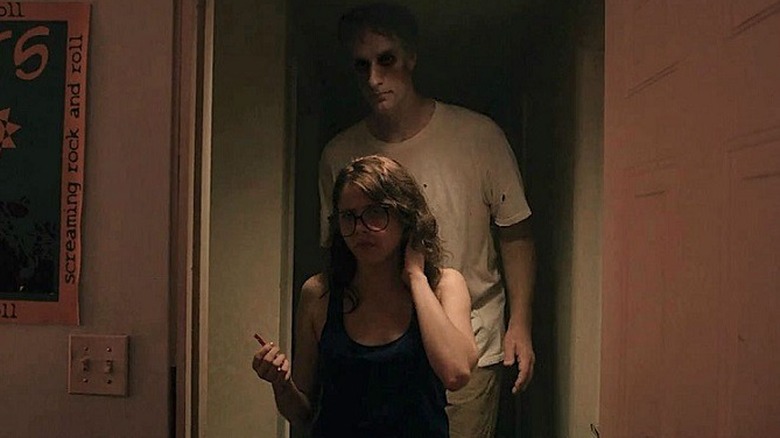
Part of a renaissance age of horror that brought horror fans "The Babadook" and "The Witch," "It Follows" introduced a new type of horror: effectively a sentient sexually transmitted infection that hunts down and brutally murderers its victims, with impending doom only held at bay by passing it on. Think "Ringu," but with more teenage groping and fumbling. Slasher movies had warned teenagers about having sex back in the '80s, and now it had come full circle.
By the end of the movie, an attempt to permanently stop the imminent encroach of the entity has met with undetermined results. As with the best of horrors, the climax is left open to interpretation. Viewers know that the entity is coming for both protagonists, Jay and Paul, as they've had sex (but an earlier shot shows Paul driving past sex workers, so he's potentially passed it on, buying them both some time).
The final shot sees the two of them walking down the street, a figure walking behind them. Is it the entity, or just a pedestrian? The ambiguity works; the entity is effectively death, unstoppable and remorseless, but there was once talk of a sequel that would flip the concept on its head and have characters research the origins of the entity.
Silence Of The Lambs (1991)
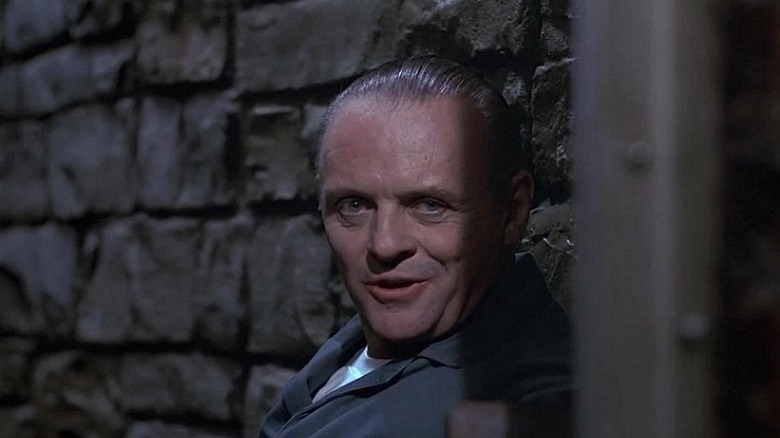
Picture the hypothetical situation: Ted Tally, screenwriter of "Silence of the Lambs" — a script based on the 1981 Thomas Harris novel of the same name — has exercised the maximum of restraint. Despite the lack of subtlety of one of the lead character's names literally rhyming with "cannibal," he's held back. He's resisted the urge to have any character ask another "What's eating you?" and anything that even hints at the FBI grilling suspects.
But, he's allowed himself one single moment of weakness, believing that brevity is key. An escaped Hannibal Lecter rings up FBI agent Clarice Starling at the movie's climax, having evaded the grasp of her bureau. He's calling Clarice to reassure her that through respect he won't go after her at all, and then he glances over at his nemesis, the head of the asylum he was locked up in, getting off a plane.
"I'm having an old friend for dinner," Hannibal says, pausing for effect before putting the phone down, all but winking at the audience. Hearing the resultant reaction of the crowds at the movie's premiere, screenwriter Ted Tally silently punches the air.
Read this next: The Horror Movies We Can't Wait To See In 2022
The post The Best Horror Movie Cliffhangers Of All Time appeared first on /Film.
